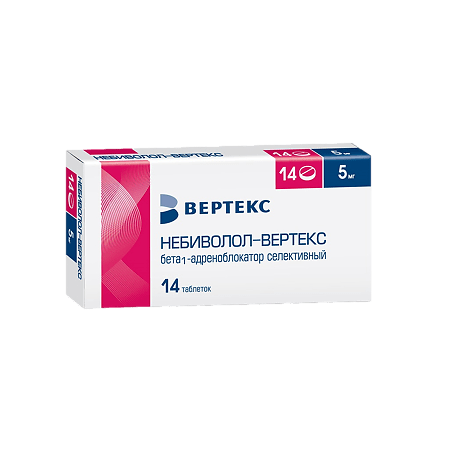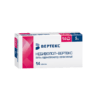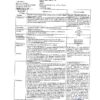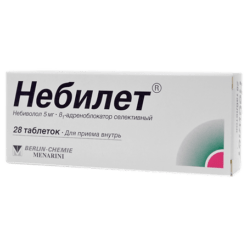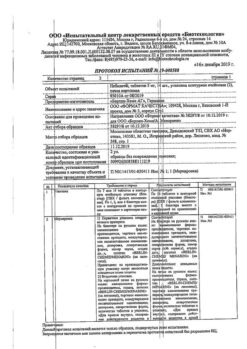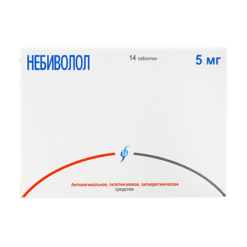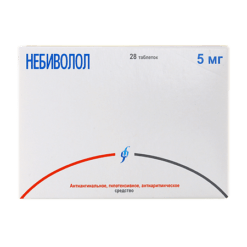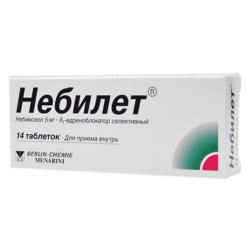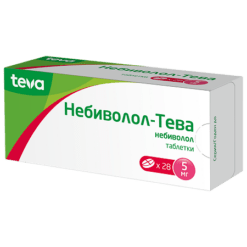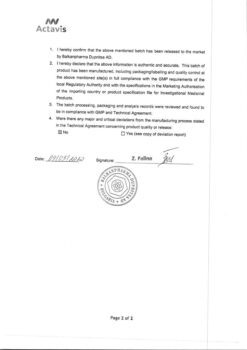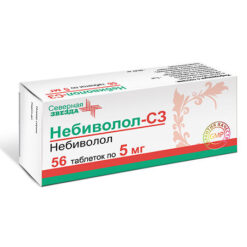No products in the cart.
Nebivolol-Vertex, tablets 5 mg 14 pcs
€8.91 €7.42
Description
Pharmacotherapeutic group
β1 selective adrenoblocker.
ATH code
C07AB12
Pharmacological properties Pharmacodynamics
Nebivolol is a third-generation cardioselective β1-adrenoblocker with vasodilatory properties. It has antihypertensive, antianginal and antiarrhythmic effects. Nebivolol reduces heart rate (HR) and blood pressure (BP) at rest and during exercise, reduces left ventricular end-diastolic pressure, improving diastolic heart function, reduces total peripheral vascular resistance, increases ejection fraction. Competitively and selectively blocks synaptic and postsynaptic β1 adrenoreceptors, making them inaccessible to catecholamines; modulates the release of endothelial vasodilatory factor nitric oxide (NO).
Nebivololol is a racemate consisting of two enantiomers: SRRR-nebivolol (D-nebivolol) and RSSS-nebivolol (L-nebivolol), combining two pharmacological actions:
– D-nebivololol is a competitive and highly selective blocker of β1 adrenoreceptors;
– L-nebivolol has a vasodilating effect by modulating the release of vasodilatory factor (NO) from the vascular endothelium.
The antihypertensive effect is also due to decrease of renin-angiotensin-aldosterone system (RAAS) activity (does not directly correlate with changes in plasma renin activity).
The antihypertensive effect comes on the 2nd-5th day of treatment, the stable effect is noted after 1-2 months. This effect persists with long-term treatment.
Limiting myocardial oxygen demand (HR slowing down, decreasing ante- and post-loading), nebivololol reduces the number and severity of angina attacks and improves exercise tolerance. Antiarrhythmic action is caused by the suppression of cardiac automatism (including in the pathological focus) and delay of atrioventricular (AV) conduction.
Pharmacokinetics
absorption
After oral administration, both enantiomers are rapidly absorbed. Food intake has no effect on absorption, so nebivolol can be taken regardless of the time of meals. Bioavailability of ingested nebivolol is on average 12% in patients with “fast” metabolism (“primary passage” effect) and is almost complete in patients with “slow” metabolism.
Distribution
In plasma both enantiomers are predominantly bound to albumin. Binding to plasma proteins is 98.1% for D-nebivolol and 97.9% for L-nebivolol.
Metabolism
Metabolized with the formation of active metabolites by alicyclic and aromatic hydroxylation and partial N-dealkylation. The resulting hydroxy- and amino derivatives conjugate with glucuronic acid and are excreted as O- and N-glucuronides. The rate at which nebivolol metabolism by aromatic hydroxylation is genetically determined by oxidative polymorphism and depends on the CYP2D6 isoenzyme.
Elimation
38% of the oral dose of nebivololol is excreted by the kidneys (the amount of unchanged nebivolol is less than 0.5%) and 48% through the intestine.
In patients with “fast” metabolism the half-life (T1/2) of hydroxymetabolites is 24 h, enantiomers of nebivololol – 10 h. In patients with “slow” metabolism T1/2 hydroxymetabolites – 48 h, enantiomers of nebivololol – 30-50 h.
With regard to differences in metabolic rate, the dose of nebivololol should always be adjusted individually: patients with “slow” metabolism require a lower dose.
Pharmacokinetics in special patient groups
Pharmacokinetic parameters have no age or sex differences.
Indications
Indications
– arterial hypertension;
– coronary heart disease: prevention of angina attacks;
– chronic heart failure (as part of combination therapy).
Pharmacological effect
Pharmacological effect
Pharmacotherapeutic group
β1-blocker selective.
ATX code
С07АВ12
Pharmacological properties
Pharmacodynamics
Nebivolol is a third-generation cardioselective β1-blocker with vasodilating properties. It has antihypertensive, antianginal and antiarrhythmic effects. Nebivolol reduces heart rate (HR) and reduces blood pressure (BP) at rest and during exercise, reduces left ventricular end-diastolic pressure, improving diastolic heart function, reduces total peripheral vascular resistance, and increases ejection fraction. Competitively and selectively blocks synaptic and postsynaptic β1-adrenergic receptors, making them inaccessible to catecholamines; modulates the release of endothelial vasodilating factor nitric oxide (NO).
Nebivolol is a racemate consisting of two enantiomers: SRRR-nebivolol (D-nebivolol) and RSSS-nebivolol (L-nebivolol), combining two pharmacological actions:
– D-nebivolol is a competitive and highly selective β1-adrenergic receptor blocker;
– L-nebivolol has a vasodilatory effect by modulating the release of vasodilating factor (NO) from the vascular endothelium.
The antihypertensive effect is also due to a decrease in the activity of the renin-angiotensin-aldosterone system (RAAS) (does not directly correlate with changes in renin activity in the blood plasma).
The antihypertensive effect occurs on days 2-5 of treatment, a stable effect is observed after 1-2 months. This effect persists with long-term treatment.
By reducing myocardial oxygen demand (reducing heart rate, reducing preload and afterload), nebivolol reduces the number and severity of angina attacks and improves exercise tolerance. The antiarrhythmic effect is due to the suppression of cardiac automaticity (including in the pathological focus) and the slowing of atrioventricular (AV) conduction.
Pharmacokinetics
Suction
After oral administration, both enantiomers are rapidly absorbed. Eating does not affect absorption, so nebivolol can be taken regardless of meal time. The bioavailability of oral nebivolol averages 12% in patients with “fast” metabolizers (first-pass effect) and is almost complete in patients with “slow” metabolizers.
Distribution
In blood plasma, both enantiomers are predominantly associated with albumin. Plasma protein binding is 98.1% for D-nebivolol and 97.9% for L-nebivolol.
Metabolism
Metabolized to form active metabolites by alicyclic and aromatic hydroxylation and partial N-dealkylation. The resulting hydroxy and amino derivatives are conjugated with glucuronic acid and are excreted in the form of O- and N-glucuronides. The rate of metabolism of nebivolol by aromatic hydroxylation is genetically determined by oxidative polymorphism and depends on the CYP2D6 isoenzyme.
Removal
38% of a dose of nebivolol taken orally is excreted by the kidneys (the amount of unchanged nebivolol is less than 0.5%) and 48% through the intestines.
In patients with “fast” metabolism, the half-life (T1/2) of hydroxymetabolites is 24 hours, of nebivolol enantiomers – 10 hours. In patients with “slow” metabolism, T1/2 of hydroxymetabolites is 48 hours, of nebivolol enantiomers – 30-50 hours.
Given differences in metabolic rates, the dose of nebivolol should always be individualized: patients with “slow” metabolism require a lower dose.
Pharmacokinetics in special groups of patients
Pharmacokinetic parameters do not have age or gender differences.
Special instructions
Special instructions
It is unacceptable to abruptly stop taking β-blockers; discontinuation of β-blockers should be carried out gradually over 10 days (up to 2 weeks in patients with coronary heart disease).
Blood pressure and heart rate should be monitored daily when starting nebivolol.
In elderly patients, monitoring of renal function is necessary (once every 4-5 months).
For exertional angina, the dose of nebivolol should ensure that the heart rate at rest is within 55-60 beats/min, and during exercise – no more than 110 beats/min.
β-blockers can cause bradycardia: the dose of nebivolol should be reduced if the heart rate is less than 50-55 beats/min (see section “Contraindications”).
When deciding on the use of nebivolol in patients with psoriasis, the expected benefits of the drug should be carefully weighed against the possible risk of exacerbation of psoriasis.
Patients who use contact lenses should take into account that the use of beta-blockers may reduce the production of tear fluid.
When performing surgical interventions, the anesthesiologist should be warned that the patient is taking β-blockers.
Nebivolol does not affect plasma glucose concentrations in patients with diabetes mellitus. However, caution should be exercised when treating these patients because nebivolol may mask certain symptoms of hypoglycemia (tachycardia, palpitations) caused by the use of oral hypoglycemic agents and insulin. In patients with diabetes mellitus, blood plasma glucose concentrations should be monitored once every 4-5 months.
With hyperthyroidism, β-blockers can mask tachycardia.
β-blockers should be used with caution in patients with chronic obstructive pulmonary disease, as bronchospasm may increase.
Nebivolol may increase symptoms of peripheral circulatory disorders.
β-blockers may increase sensitivity to allergens and the severity of anaphylactic reactions. Nebivolol can cause severe reactions to a number of allergens when administered to patients with a history of severe anaphylactic reactions to these allergens. These patients may not respond to the usual doses of epinephrine (adrenaline) used to treat anaphylactic shock.
The effectiveness of β-blockers in smokers is lower than in non-smoking patients.
Effect on the ability to drive vehicles and machines The effect of nebivolol on the ability to drive vehicles and machines has not been studied. During treatment with nebivolol (if side effects occur), caution should be exercised when driving vehicles and machinery and when engaging in potentially hazardous activities that require increased concentration and speed of psychomotor reactions.
Active ingredient
Active ingredient
Nebivolol
Composition
Composition
One tablet contains:
active ingredient:
nebivolol hydrochloride – 5.45 mg (in terms of nebivolol – 5.00 mg);
excipients:
lactose monohydrate – 139.91 mg;
corn starch – 46.00 mg;
microcrystalline cellulose – 16.10 mg;
croscarmellose sodium – 13.80 mg;
hyprolose (hydroxypropylcellulose) – 4.60 mg;
polysorbate 80 – 2.30 mg;
magnesium stearate – 1.15 mg;
colloidal silicon dioxide – 0.69 mg.
Pregnancy
Pregnancy
Pregnancy
During pregnancy, nebivolol is prescribed only for strict indications, when the benefit to the mother outweighs the risk to the fetus (due to the possibility of delayed development and growth of the fetus, intrauterine fetal death, premature birth, as well as the development of bradycardia in the newborn, decreased blood pressure, hypoglycemia and respiratory paralysis). Treatment must be interrupted 48-72 hours before delivery. In cases where this is not possible, it is necessary to monitor uteroplacental blood flow and fetal growth, as well as ensure strict monitoring of the newborn during the first three days after delivery.
Breastfeeding period
Animal studies have shown that nebivolol is excreted in breast milk. If it is necessary to take the drug during breastfeeding, breastfeeding should be stopped.
Contraindications
Contraindications
– hypersensitivity to nebivolol or any of the components of the drug and other beta-blockers;
– acute heart failure;
– chronic heart failure in the stage of decompensation (requiring intravenous administration of drugs with inotropic effects);
– severe arterial hypotension (systolic blood pressure less than 90 mm Hg);
– sick sinus syndrome, including sinoauricular block;
– AV block II and III degrees (in the absence of an artificial pacemaker);
– severe bradycardia (heart rate less than 50 beats/min);
– cardiogenic shock;
– pheochromocytoma (without simultaneous use of α-blockers);
– metabolic acidosis;
– severe liver dysfunction;
– history of bronchial asthma and bronchospasm;
– severe peripheral circulatory disorders (“intermittent” claudication, Raynaud’s syndrome);
– myasthenia gravis, muscle weakness;
– depression;
– lactose intolerance, lactase deficiency, glucose-galactose malabsorption syndrome;
– age under 18 years (efficacy and safety have not been established);
– simultaneous use with floctafenine, sultopride (see section “Interaction with other drugs”);
– intravenous administration of verapamil during the use of nebivolol;
– severe renal failure (creatinine clearance (CC) less than 20 ml/min).
With caution
– mild to moderate peripheral circulatory disorders;
– impaired renal function (creatinine clearance more than 20 ml/min);
– diabetes mellitus;
– hyperfunction of the thyroid gland;
– aggravated allergic history, desensitizing therapy, psoriasis;
– chronic obstructive pulmonary disease;
– AV block of the first degree;
– Prinzmetal’s angina;
– age over 65 years.
Side Effects
Side Effects
Classification of the incidence of side effects according to the recommendations of the World Health Organization (WHO):
very often > 1/10;
often from > 1/100 to < 1/10;
infrequently from > 1/1000 to < 1/100;
rarely from > 1/10000 to < 1/1000;
very rarely <1/10000, including isolated reports;
frequency unknown – based on available data, it is not possible to determine the frequency of occurrence.
From the nervous system:
often – headache, dizziness, increased fatigue, weakness, paresthesia;
infrequently – depression, nightmares, confusion, decreased ability to concentrate, drowsiness, insomnia;
very rarely – fainting, hallucinations.
From the digestive system:
often – nausea, constipation, diarrhea, dry oral mucosa; infrequently – dyspepsia, flatulence, vomiting.
From the cardiovascular system:
often – peripheral edema;
uncommon – bradycardia, acute heart failure, worsening of chronic heart failure, AV block, slowing of AV conduction, decreased blood pressure, orthostatic hypotension, cardiac arrhythmias, cardialgia, exacerbation of intermittent claudication, Raynaud’s syndrome.
From the skin:
uncommon – erythematous skin rash, itching;
very rarely – aggravation of psoriasis, photodermatosis, increased sweating; frequency unknown – urticaria.
Allergic reactions:
frequency unknown – angioedema, hypersensitivity.
From the respiratory system:
often – shortness of breath;
infrequently – bronchospasm (including in the absence of a history of obstructive pulmonary diseases), rhinitis.
From the reproductive system:
infrequently – erectile dysfunction.
From the senses:
uncommon – blurred vision, dry eyes.
Others:
frequency unknown – alopecia.
Interaction
Interaction
Pharmacodynamic interaction
The simultaneous use of nebivolol and floctafenine is contraindicated, as there is a risk of developing severe arterial hypotension or shock.
The simultaneous use of nebivolol and sultopride is contraindicated, as the risk of developing ventricular arrhythmia, especially ventricular tachycardia of the “pirouette” type, increases.
With the simultaneous use of β-blockers with blockers of “slow” calcium channels (SCBC) (verapamil and diltiazem), the negative effect on myocardial contractility and AV conductivity increases. Intravenous administration of verapamil is contraindicated while using nebivolol.
The simultaneous use of nebivolol and dihydropyridine BMCC (amlodipine, felodipine, lacidipine, nifedipine, nicardipine, nimodipine, nitrendipine) may increase the risk of arterial hypotension. An increased risk of further reduction in myocardial contractility in patients with heart failure cannot be excluded.
When nebivolol is used concomitantly with antihypertensive drugs, nitroglycerin or BMCC, severe arterial hypotension may develop (special caution is required when combined with prazosin).
The simultaneous use of baclofen and amifostine with antihypertensive drugs can cause a significant decrease in blood pressure, so dose adjustment of antihypertensive drugs is required.
With the simultaneous use of nebivolol with centrally acting antihypertensive drugs (clonidine, guanfacine, moxonidine, methyldopa, rilmenidine), the course of heart failure may worsen due to a decrease in sympathetic tone (decreased heart rate and cardiac output, symptoms of vasodilation). In case of abrupt withdrawal of these drugs, especially before discontinuation of nebivolol, the development of “rebound” arterial hypertension is possible.
With the simultaneous use of nebivolol with class I antiarrhythmic drugs (quinidine, hydroquinidine, cibenzoline, flecainide, disopyramide, lidocaine, mexiletine, propafenone) and with amiodarone, an increase in the negative inotropic effect and prolongation of the conduction time of excitation in the atria is possible.
Concomitant use of nebivolol with cardiac glycosides may cause a slowdown in AV conduction. However, according to the results of clinical studies of nebivolol, there was no indication of this interaction.
The simultaneous use of nebivolol and drugs for general anesthesia may suppress reflex tachycardia and increase the risk of developing arterial hypotension.
No clinically significant interaction between nebivolol and non-steroidal anti-inflammatory drugs has been established.
Acetylsalicylic acid as an antiplatelet agent can be used simultaneously with nebivolol.
Concomitant use of nebivolol with tricyclic antidepressants, barbiturates and phenothiazine derivatives may enhance the antihypertensive effect of nebivolol.
With simultaneous use of nebivolol with insulin and hypoglycemic
Oral medications may mask the symptoms of hypoglycemia (tachycardia, rapid heartbeat).
When used concomitantly, sympathomimetic agents inhibit the activity of nebivolol.
Pharmacokinetic interaction
With simultaneous use of nebivolol with drugs that inhibit serotonin reuptake, or other drugs that are biotransformed with the participation of the CYP2D6 isoenzyme (for example, paroxetine, fluoxetine, thioridazine, quinidine), the concentration of nebivolol in the blood plasma increases, the metabolism of nebivolol slows down, which can lead to the risk of bradycardia.
When used concomitantly with digoxin, nebivolol does not affect the pharmacokinetic parameters of digoxin.
With simultaneous use of nebivolol with cimetidine, the concentration of nebivolol in the blood plasma increases.
The simultaneous use of nebivolol and ranitidine does not affect the pharmacokinetic parameters of nebivolol.
Rifampin increases the metabolism of nebivolol.
With simultaneous use of nebivolol with nicardipine, the concentrations of both substances in the blood plasma increase slightly without changing the clinical effect.
Concomitant use of nebivolol and ethanol, furosemide or hydrochlorothiazide does not affect the pharmacokinetic parameters of nebivolol.
No clinically significant interaction between nebivolol and warfarin has been established.
Overdose
Overdose
Symptoms
Marked decrease in blood pressure, nausea, vomiting, cyanosis, severe bradycardia, AV block, bronchospasm, loss of consciousness, cardiogenic shock, coma, acute heart failure, cardiac arrest, hypoglycemia, convulsions.
Treatment
Gastric lavage, taking activated carbon. In case of a pronounced decrease in blood pressure, it is necessary to place the patient in a horizontal position with elevated legs, and, if necessary, intravenous fluid and vasopressors. For bradycardia, 0.5-2 mg of atropine should be administered intravenously; if there is no positive effect, a transvenous or intracardiac pacemaker may be installed. For II-III degree AV block, intravenous administration of β-adrenergic agonists is recommended; if they are ineffective, the issue of installing an artificial pacemaker should be considered. In case of heart failure, treatment begins with the administration of cardiac glycosides and diuretics; if there is no effect, it is advisable to administer dopamine, dobutamine or vasodilators. For bronchospasm, β2-adrenergic agonists are used intravenously. For ventricular extrasystole – lidocaine (class IA antiarrhythmic drugs cannot be administered). For hypoglycemia – intravenous dextrose (glucose) solution, for convulsions – intravenous diazepam.
Storage conditions
Storage conditions
Store in a place protected from light at a temperature not exceeding 25 ºС. Keep out of the reach of children.
Shelf life
Shelf life
3 years.
Do not use after expiration date.
Manufacturer
Manufacturer
Vertex, Russia
Additional information
| Shelf life | 3 years. Do not use after the expiration date. |
|---|---|
| Conditions of storage | Store in a light-protected place at a temperature not exceeding 25 ºC. Keep out of the reach of children. |
| Manufacturer | Vertex, Russia |
| Medication form | pills |
| Brand | Vertex |
Other forms…
Related products
Buy Nebivolol-Vertex, tablets 5 mg 14 pcs with delivery to USA, UK, Europe and over 120 other countries.

